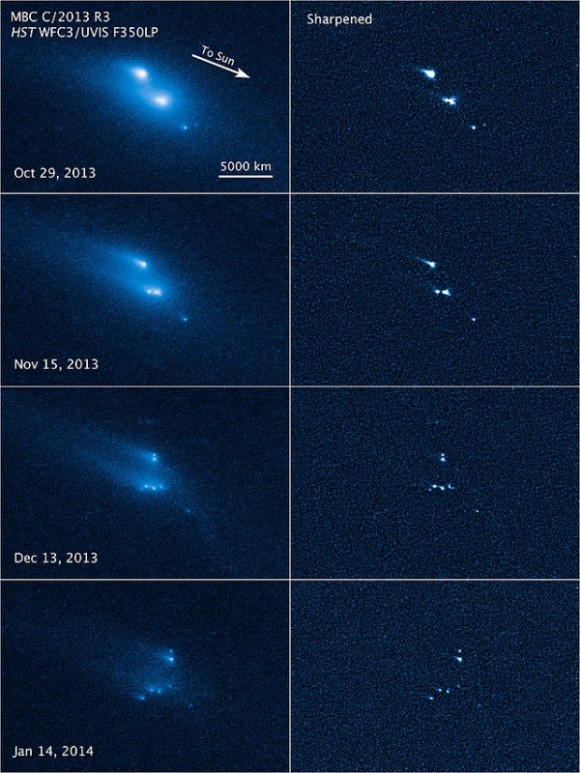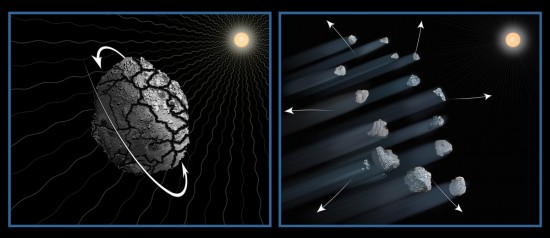The breakup of an asteroid
Eight years ago today, the peer-reviewed Astrophysical Journal Letters first published a study of the breakup of an asteroid. It was the first asteroid we’ve ever witnessed break up, and, so far, it’s been the only one.
The asteroid, discovered in September, 2013, in the Catalina and Pan-STARRS sky surveys, received the designation P/2013 R3. Shortly after its discovery, astronomers using the Keck Telescope in Hawaii showed not one, but three bodies traveling together. A dusty envelope nearly as wide as the Earth surrounded them.
Hubble Space Telescope observations – and subsequent computer modeling – showed that P/2013 R3 probably started out less than about a quarter of a mile (400 meters) in radius and probably weighed about 200,000 tons. It broke up into at least 13 pieces, the biggest of which was likely no more than about 600 feet (200 meters) in size.
Fragile icy comet nuclei sometimes fall apart as they approach the sun. But asteroids are not, by definition, fragile icy bodies. They’re chunks of rock or metal. David Jewitt of UCLA, who led the astronomical investigation, said at the time:
This is a rock. Seeing it fall apart before our eyes is pretty amazing.

Break up of an asteroid: Why did it happen?
Jewitt and the other scientists who studied P/2013 R3 pointed out that, because the asteroid seemed to disintegrate slowly over a period of months, it was unlikely that a violent and sudden collision with another asteroid caused the breakup.
They said it was also unlikely that the asteroid broke apart due to the pressure of interior ices warming and vaporizing as the asteroid drew near the sun. Icy comets do become active for this reason, and do sometimes disintegrate, but scientists believed P/2013 R3 was too cold for such a process, plus it had presumably maintained its nearby distance from the sun (~300 million miles, or ~480 million km) for much of the age of our solar system.
That left a possible scenario in which the asteroid disintegrated due to a subtle effect of sunlight – known as the YORP effect – which would cause the rotation rate to increase slowly over time. Eventually, the component pieces of the asteroid would gently pull apart due to centrifugal force.
Fractured interior
For a breakup to occur in this way, P/2013 R3 would have needed to have a weak, fractured interior. That fractured interior might have been the result of numerous ancient and non-destructive collisions with other asteroids, early in the solar system’s history. Scientists think most small asteroids have been severely damaged in this way, giving them a “rubble pile” internal structure.
Thus, P/2013 R3 itself was probably the product of collisional shattering of a bigger body sometime in the last billion years.
Astronomers have said that most of P/2013 R3’s remnant debris will eventually plunge into the sun. But some will become a rich source for future meteor showers and may even one day cross Earth’s sky as meteors.

Active asteroids
By the way, P/2013 R3 is one of several objects known as active asteroids (called main-belt comets by some astronomers). They have the orbits of asteroids – inside the orbit of the giant planet Jupiter – but they look like comets in that they show tails. Some astronomers call them main-belt comets, but, according to David Jewitt:
… this was misinterpreted by many people to mean that the active objects are necessarily icy. In most cases, we don’t know if they are icy. In some cases we know that they are not.
Besides P/2013 R3, the list of currently known active asteroids includes 101955 Bennu, 3200 Phaethon, Ceres and others.
Read more about active asteroids from Dave Jewitt
Bottom line: Astronomers observed the asteroid known as P/2013 R3 to break up into as many as 13 smaller pieces from late 2013 to early 2014.
Source: Anatomy of an Asteroid Breakup: The Case of P/2013 R3
Source: Disintegrating asteroid P/2013 R3
The post Breakup of an asteroid: 8th anniversary first appeared on EarthSky.
0 Commentaires